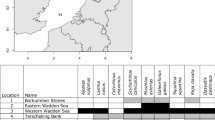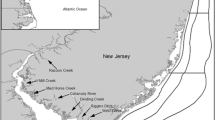Abstract
Diets of demersal fishes were determined on the shelf (ca. 130 m deep) off Iwate, Japan. Samples were taken in three different types of habitat, an artificial reef (AR) site, a natural reef (NR) site, and sandymud bottom (SB) site, from May 1987 to September 1991, mostly every two months. A total of 67 prey items were recognized in the stomachs of 45 predator fish species. The most important preys were the pelagic fishes Sardinops melanostictus and Engraulis japonicus, which comprised 37% wet wt of the overall stomach contents. The percentage of pelagic fishes was highest at AR site, where fish density was highest. The dominant ten species could be divided into five feeding types. The pelagic fish feeders Physiculus maximowiczi and Gadus macrocephalus fed mainly on S. melanostictus. The dietary breadth of P. maximowiczi was wide, while that of Gadus macrocephalus was narrow. The pelagic crustacean feeder Theragra chalcogramma mostly consumed Themisto japonica and euphausiids and showed the least dietary overlap with other fishes. Benthic fish feeders were Hemitripterus villosus and Liparis tanakai. The benthic crustacean feeders Alcichthys alcicornis and Hexagrammos otakii consumed benthic crustaceans as well as pelagic and benthic fishes and showed the largest dietary breadth. The benthic invertebrate feeders Gymnocanthus intermedius, Dexistes rikuzenius and Tanakius kitaharai fed mainly on polychaetes and benthic crustaceans. But Gymnocanthus intermedius consumed a significant proportion of pelagic fishes. Ontogenetic dietary shift was recognized for these fishes. Pelagic fishes were consumed more intensively by larger individuals, especially true of A. alcicornis, Theragra chalcogramma and Gadus macrocephalus. Predominancy of the two most adundant species, P. maximowiczi and A. alcicornis, may be supported by their wide dietary breadth and the significant proportion of pelagic fish in their diets. Interspecific dietary overlap was low in most cases suggesting that food resources were well partitioned, although some high overlap was observed among the pelagic fish feeders, A. alcicornis, and Gymnocanthus intermedius, and among the benthic invertebrate feeders. Interspecific competition seemed more likely in the benthic invertebrate feeders than in the pelagic fish feeders partly because of superabundance of the pelagic prey S. melanostictus.
Similar content being viewed by others
References
Blaber SJM, Bulman CM (1987) Diets of fishes of the upper continental slope of eastern Tasmania: content, calorific values, dietary overlap and trophic relationships. Mar Biol 95: 345–356
Crabtree RE, Carter J, Musick JA (1991) The comparative feeding ecology of temperate and tropical deep-sea fishes from the western North Atlantic. Deep-Sea Res 38: 1277–1298
Dwyer DA, Bailey KM, Livingston PA (1987) Feeding habits and daily ration of walleye pollock (Theragra chalcogramma) in the eastern Bering Sea, with special reference to cannibalism. Can J Fish aquat Sci 44: 1972–1984
Fujita T (1993) Community ecology of offshore demersal fish assemblages. Benthos Res 44: 1–17 (in Japanese with English abstract and legends)
Fujita T, Inada T, Ishito Y (1993) Density, biomass and community structure of demersal fishes off the Pacific coast of northeastern Japan. J Oceanogr 49: 211–229
Fujita T, Inada T, Ishito Y (1995) Depth-gradient structure of the demersal fish community on the continental shelf and upper slope off Sendai Bay, Japan. Mar Ecol Prog Ser 118: 13–23
Gibson RN, Ezzi IA (1987) Feeding relationships of a demersal fish assemblage on the west coast of Scotland. J Fish Biol 31: 55–69
Hacunda JS (1981) Trophic relationships among demersal fishes in a coastal area of the Gulf of Maine. Fish Bull US 79: 775–788
Haedrich RL (1974) Pelagic capture of the epibenthic rattail Coryphaenoides rupestris. Deep-Sea Res 21: 977–979
Haedrich RL, Henderson NR (1974) Pelagic food of Coryphaenoides armatus, a deep benthic rattail. Deep-Sea Res 21: 739–744
Hashimoto R (1974) Investigation of feeding habits and variation of inhabiting depths with cod (Gadus macrocephalus) distributed in the northeastern fishing ground in Japan. Bull Tohoku reg Fish Res Lab 33: 51–67 (in Japanese with English abstract)
Henderson PA, James D, Holmes RHA (1992) Trophic structure within the Bristol Channel: seasonality and stability in Bridg-water Bay. J mar biol Ass UK 72: 675–690
Hiroki M (1988) Relation between diel vertical migration and locomotor activity of a marine hyperiidean amphipod, Themisto japonica (Boyallius). J Crustacean Biol 8: 48–52
Horn HS (1966) Measurement of “overlap” in comparative ecological studies. Am Nat 100: 419–424
Houston KA, Haedrich RL (1986) Food habits and intestinal parasites of deep demersal fishes from the upper continental slope east of Newfoundland, northwest Atlantic Ocean. Mar Biol 92: 563–574
Hyslop EJ (1980) Stomach content analysis — a review of methods and their application. J Fish Biol 17: 411–429
Kanamoto Z (1976) On the ecology of hexagrammid fish. 1. Habitats and behaviors of Agrammus agrammus (Temminck et Schlegel) and Hexagrammos otakii (Jordan et Starks). Jap J Ecol 26: 1–12 (in Japanese with English abstract and legends)
Kitagawa D (1984) Seasonal change of the fish fauna and its structure around artifical reefs off Iwate. Fish Engng 21: 11–17 (in Japanese with English abstract)
Kitagawa D (1990) Groundfish community in the coastal waters off Iwate Prefecture. Bull Tohoku natn Fish Res Inst 52: 45–63 (in Japanese with English abstract and legends)
Kitagawa D (1991) The relationship between the artificial reef density and the catch of the brown hakeling in the coastal waters of Iwate Prefecture. Fish Engng 27: 13–17 (in Japanese with English abstract and legends)
Kitagawa D, Ishito Y, Okuyama Y, Sakurai Y, Inada T (1992) Preys discared by the Japanese common squid, Todarodes pacificus, occurring in the stomachs of brown hakeling, Physiculus maximowiczi. Bull Tohoku natn Fish Res Inst 54: 59–66 (in Japanese with English abstract and legends)
Kotani Y, Odate K, Ueno Y, Ishida K (1988) Some variations in zooplankton biomass in the waters off the coast of Sanriku, northeastern Japan. Bull Tokoku reg Fish Res Lab 50: 125–131 (in Japanese with English abstract and legends)
Langton RW (1982) Diet overlap between Atlantic cod, Gadus morhua, silver hake, Merluccius bilinearis, and fifteen other north-west Atlantic finfish. Fish Bull US 80: 745–759
Levins R (1968) Evolution in changing environments: some theoretical explorations. Princeton University Press, Princeton
Macpherson E (1979) Ecological overlap between macrourids in the western Mediterranean Sea. Mar Biol 53: 149–159
Macpherson E (1981) Resource partitioning in a Mediterranean demersal fish community. Mar Ecol Prog Ser 4: 183–193
Macpherson E, Roel BA (1987) Trophic relationships in the demersal fish community off Namibia. S Afr J mar Sci 5: 585–596
Marshall NB (1979) Developments in deep-sea biology. Blandford, Poole, UK
Matsuda H, Wada T, Takeuchi Y, Matsumiya Y (1992) Model analysis of the effect of environmental fluctuation on the species replacement pattern of pelagic fishes under inter-specific competition. Res Popul Ecol 34: 309–319
Mauchline J, Gordon JDM (1984) Diets and bathymetric distributions of the macrourid fish of the Rockall Trough, northeastern Atlantic Ocean. Mar Biol 81: 107–121
Mauchline J, Gordon JDM (1985) Trophic diversity in deep-sea fish. J Fish Biol 26: 527–535
Mauchline J, Gordon JDM (1986) Foraging strategies of deep-sea fish. Mar Ecol Prog Ser 27: 227–238
Mauchline J, Gordon JDM (1991) Oceanic pelagic prey of benthopelagic fish in the benthic boundary layer of a marginal oceanic region. Mar Ecol Prog Ser 74: 109–115
McKenna JE Jr (1991) Trophic relationships within the Antarctic demersal fish community of South Georgia Island. Fish Bull 89: 643–654
McLellan T (1977) Feeding strategies of the macrourids. Deep-Sea Res 24: 1019–1036
Mio S, Tagawa M, Shinohara F, Yamada U (1984) Ecological study on the demersal fish associations in the East China Sea and the Yellow Sea, with reference to food relationships. Bull Seikai reg Fish Res Lab 61: 1–221 (in Japanese with English abstract and legends)
Morisita M (1959) Measuring of interspecific association and similarity between communities. Mem Fac Sci Kyushu Univ Ser E (Biol) 3: 65–80
Nozu J (1966) On the swimming layer of Engraulis japonica shoals in Bungo Channel and its adjacent waters. Bull Jap Soc scient Fish 32: 237–241 (in Japanese with English abstract and legends)
Odate K (1991) Fishery biology of krill, Euphausia pacifica, in the northeastern coasts of Japan. Japan Fisheries Resource Conservation Association, Tokyo (in Japanese)
Ogasawara Y, Kawasaki T (1980) Life history of migigarei, Dexistes rikuzenius (Jordan et Starks), in Sendai Bay, with special reference to sexual dimorphism. Tohoku J agric Res 30: 163–182
Ogata T (1956) Theragra chalcogramma. Bull Japan Sea reg Fish Res Lab 4: 93–139 (in Japanese)
Omori M (1975) A study on the production ecology of demersal fishes in Sendai Bay II. Interspecific relationships concerning habitat and food. Bull Japan Soc scient Fish 41: 615–629 (in Japanese with English abstract)
Omori M (1979) Studies on the production ecology of demersal fishes in Sendai Bay IV. Feeding relations in demersal fish community. Bull Seikai reg Fish Res Lab 52: 131–168 (in Japanese with English abstract)
Owatari A, Furuno K (1954) The behaviors of the sardine schools by fish-detector II. Influences of the water temperature when attracting the fish schools by fishing light. Bull Jap Soc scient Fish 19: 1072–1076 (in Japanese with English abstract and legends)
Pearcy WG, Ambler JW (1974) Food habits of deep-sea macrourid fishes off the Oregon coast. Deep-Sea Res 21: 745–759
Pianka ER (1981) Competition and niche theory. In: May RM (ed) Theoretical ecology, 2nd edn. Blackwell, Oxford, pp 167–196
Ross ST (1986) Resource partitioning in fish assemblages: a review of field studies. Copeia 1986: 352–388
Roughgarden J (1986) A comparison of food-limited and space-limited animal competition communities. In: Diamond J, Case TJ (eds) Community ecology. Harper & Row, New York, pp 492–516
Sedberry GR, Musick JA (1978) Feeding strategies of some demersal fishes of the continental slope and rise off the mid-Atlantic coast of the USA. Mar Biol 44: 357–375
Semenova TN (1974) Diurnal vertical migration of Parathemisto japonica Bov. (Hyperiidea) in the Sea of Japan. Oceanology, Wash 14: 272–276
Targett TE (1981) Trophic ecology and structure of coastal Antarctic fish communities. Mar Ecol Prog Ser 4: 243–263
Werner EE (1986) Species interactions in freshwater fish communities. In: Diamond J, Case TJ (eds) Community ecology. Harper & Row, New York, pp 344–358
Yamamura O (1994) Ecological study on demersal fish community off Sendai Bay, northern Japan, with special reference to niche dynamics among dominant fishes. Doctoral dissertation, Hokkaido University, Hakodate
Yamashita Y, Kitagawa D, Aoyama T (1985) A field study of predation of the hyperiid amphipod Parathemisto japonica on larvae of the Japanese sandeel Ammodytes personatus. Bull Japan Soc scient Fish 51: 1599–1607
Author information
Authors and Affiliations
Additional information
Communicated by T. Ikeda, Hiroshima
Rights and permissions
About this article
Cite this article
Fuita, T., Kitagawa, D., Okuyama, Y. et al. Diets of the demersal fishes on the shelf off Iwate, northern Japan. Marine Biology 123, 219–233 (1995). https://doi.org/10.1007/BF00353613
Received:
Accepted:
Issue Date:
DOI: https://doi.org/10.1007/BF00353613




